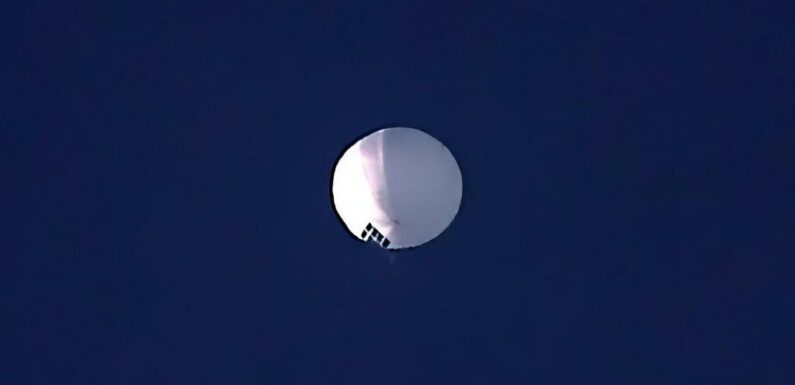
By MATTHEW LEE
WASHINGTON (AP) — A huge, high-altitude Chinese balloon sailed across the U.S. on Friday, drawing severe Pentagon accusations of spying despite China’s firm denials. Secretary of State Antony Blinken abruptly canceled a high-stakes Beijing trip aimed at easing U..S.-China tensions.
Fuzzy videos dotted social media sites as people with binoculars and telephoto lenses tried to find the “spy balloon” in the sky as it headed eastward over Kansas and Missouri at 60,000 feet.
Blinken’s cancelation came despite China’s claim that the balloon was merely a weather research “airship” that had blown off course. The Pentagon rejected that out of hand — as well as China’s contention that the balloon, about the size of two school buses, was not being used for surveillance and had only limited navigational ability.
The balloon was detected over sensitive military sites in Montana but had moved eastward over the heartland of the central United States by midday and was expected to remain in U.S. airspace for several days, officials said.
The development marked a new blow to already strained U.S.-Chinese relations that have been in a downward spiral for years over numerous issues. Still, U.S. officials maintained that diplomatic channels remain open and that Blinken was willing to travel to China at “an appropriate time.”
President Joe Biden declined to comment on the matter when questioned at an economic event. Two 2024 reelection challengers, former President Donald Trump, and Nikki Haley, the former South Carolina governor and U.N. ambassador, said the U.S. should immediately shoot down the balloon.
Biden was first briefed about the Chinese surveillance balloon on Tuesday, White House press secretary Karine Jean-Pierre told reporters. She did not shed light on why the administration waited until Thursday to make its concerns public.
A senior defense official said the U.S. had prepared fighter jets, including F-22s, to shoot the balloon down if ordered. The Pentagon ultimately recommended against that, noting that even as the balloon was over a sparsely populated area of Montana, its size could create a debris field large enough to put people at risk.
Brig. Gen. Pat Ryder, Pentagon press secretary, refused to say on Friday whether there was any new consideration of shooting the balloon down.
Ryder said it was at an altitude of about 60,000 feet, was maneuverable and had changed course. He said it currently was posing no threat.
As for Blinken’s trip, Jean-Pierre said a diplomatic visit to China was not appropriate at this time. She said that “the presence of this balloon in our airspace … is a clear violation of our sovereignty as well as international law and it is unacceptable this occurred.”
A State Department official said Blinken and Deputy Secretary of State Wendy Sherman had both protested to the top official at the Chinese Embassy on Wednesday, a day before the Pentagon announced the discovery of the balloon.
Pentagon officials said Thursday that one of the places it was spotted was over Montana, which is home to one of America’s three nuclear missile silo fields at Malmstrom Air Force Base.
A number of GOP lawmakers have criticized the administration for not taking firmer action against China before this. And a decision for Blinken to proceed with his trip could have made Biden even more susceptible to their complaints at a time he’s starting to deal with the new Republican-led U.S. House.
Weather experts said China’s claim that the balloon had gone off course was not unfeasible. China’s account of wind patterns known as the Westerlies carrying a balloon to the western United States was “absolutely possible – not possible, likely,” said Dan Jaffe, a professor of atmospheric chemistry at the University of Washington.
Still multiple U.S. officials called the presence of the balloon “unacceptable” and said that message had been delivered by Blinken to Chinese State Councilor Wang Yi on Friday when he told them he was postponing his trip.
State Department spokesman Ned Price said in a statement that Blinken had told Wang that “the United States is committed to diplomatic engagement and maintaining open lines of communication, and that he would be prepared to visit Beijing as soon as conditions allow.”
Blinken’s long-anticipated meetings with senior Chinese officials had been seen in both countries as a possible way to find some areas of common ground at a time of major disagreements over Taiwan, human rights, China’s claims in the South China Sea, North Korea, Russia’s war in Ukraine, trade policy and climate change.
Although the trip, which was agreed to in November by Biden and Chinese President Xi Jinping at a summit in Indonesia, had not been formally announced, officials in both Beijing and Washington had spoken in recent days about Blinken’s imminent arrival for meetings on Sunday and Monday.
China, which angrily denounces surveillance attempts by the U.S. and others over areas it considers to be its territory and once forced down an American spy plane and held its crew captive on Hainan Island, was relatively conciliatory in its response to the U.S. complaints.
In a statement that approached an apology, the Chinese foreign ministry said the balloon was a civilian airship used mainly for meteorological research. It said said the airship had limited “self-steering” capabilities and had “deviated far from its planned course” because of winds.
“The Chinese side regrets the unintended entry of the airship into U.S. airspace due to force majeure,” the statement said, citing a legal term used to refer to events beyond one’s control.
___
Ellen Knickmeyer, Tara Copp, Lolita C. Baldor, Aamer Madhani and Zeke Miller in Washington; Matthew Brown in Billings, Montana, and Emily Wang Fujiyama and AP news assistant Caroline Chen in Beijing contributed to this report.
Source: Read Full Article